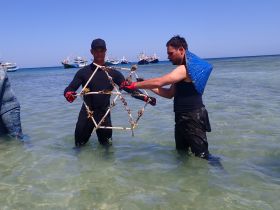Managing country with fire
My name is Dameon Hunter, I’m the Djabugay Rangers Coordinator and we’re out here on Djabugay country, Nadjon Bulmba.
We’re here to talk about cultural burning and traditional practices. It’s important for us to bring back traditional practices to help maintain our country.
This once used to be open woodland country, but now you can see it’s unhealthy country. Overgrown grasslands, introduced weeds, and introduced tree species. But by using our knowledge and by passing down from generations to generations, over thousands of years, we can start the healing process of our country.
This is done by putting in the right burns at the right times of year. This will help our native trees, put in the right soil, help our bush foods and bush medicine trees, and also help the wildlife but most importantly it will help the prevention of wildfires.
Healthy country, Bulmba gurri, equals healthy people, Bama gurri.
So we got a spiritual song that we use when putting a cultural burn in and this will help heal the country and help bring back our bush foods, our bush medicines that’s important for our people.
(Singing in language)
Here we have healthy country. This is due to the correct fires that’s been put in place by us, at the right time of year.
Here we have our native tree species, the bloodwood, which is the most dominant tree for this country, which thrives on these fires.
Down here, we have our native grasses. Here we have our kangaroo grass, in our language we say the Nguyay. Also we have the Dalmba (lomandra) grass, which our people use for basket weaving. These are all good indications of healthy country. That’s why it’s important for us to practise our traditional knowledge.
I want to explain why it’s important, why we have to do cultural burning around our waterways. If we put a hot burn through here, all of this edge of the lagoon here will eventually get burnt and it will start to dry up the lagoon. And then the fish life inside of there, the freshwater turtles, the fishes, ah you get the eels as well, they’ll eventually all disappear, and be gone. So that’s why we need to put the right burn in at the right time of year.
It’s very important and also I’m very privileged to be working on my own country. Not many people can say that, that they get the chance to work on their own country. Because having that knowledge that’s been passed down from my ancestors to me, it just makes me want to strive and do more to help our country and get it back to how it used to be thousands of years ago.




















